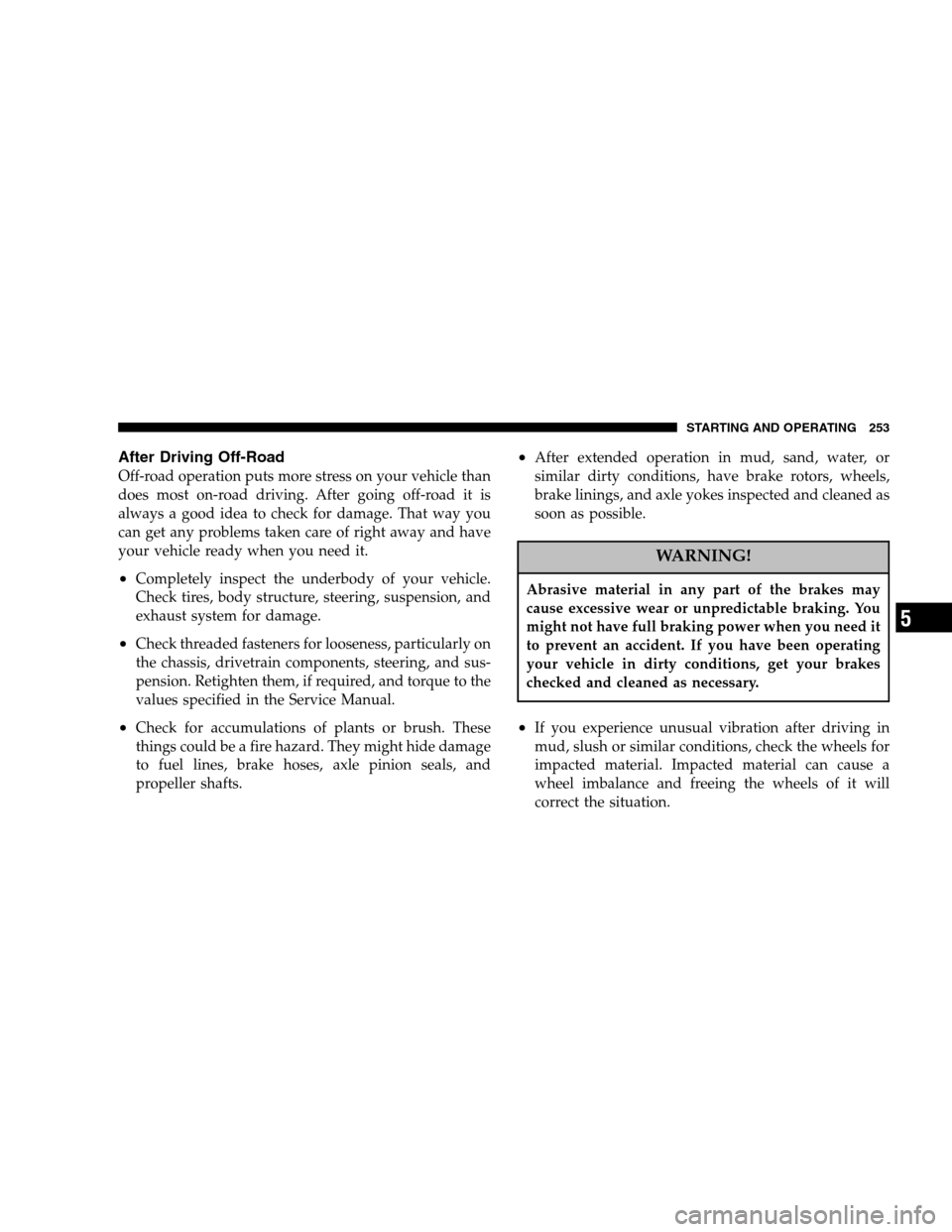Page 253 of 408

After Driving Off-Road
Off-road operation puts more stress on your vehicle than
does most on-road driving. After going off-road it is
always a good idea to check for damage. That way you
can get any problems taken care of right away and have
your vehicle ready when you need it.
•Completely inspect the underbody of your vehicle.
Check tires, body structure, steering, suspension, and
exhaust system for damage.
•Check threaded fasteners for looseness, particularly on
the chassis, drivetrain components, steering, and sus-
pension. Retighten them, if required, and torque to the
values specified in the Service Manual.
•Check for accumulations of plants or brush. These
things could be a fire hazard. They might hide damage
to fuel lines, brake hoses, axle pinion seals, and
propeller shafts.
•After extended operation in mud, sand, water, or
similar dirty conditions, have brake rotors, wheels,
brake linings, and axle yokes inspected and cleaned as
soon as possible.
WARNING!
Abrasive material in any part of the brakes may
cause excessive wear or unpredictable braking. You
might not have full braking power when you need it
to prevent an accident. If you have been operating
your vehicle in dirty conditions, get your brakes
checked and cleaned as necessary.
•If you experience unusual vibration after driving in
mud, slush or similar conditions, check the wheels for
impacted material. Impacted material can cause a
wheel imbalance and freeing the wheels of it will
correct the situation.
STARTING AND OPERATING 253
5
Page 268 of 408

WARNING!
•Do not use a tire, wheel size or rating other than that
specified for your vehicle. Some combinations of un-
approved tires and wheels may change suspension
dimensions and performance characteristics, resulting
in changes to steering, handling, and braking of your
vehicle. This can cause unpredictable handling and
stress to steering and suspension components. You
could lose control and have an accident resulting in
serious injury or death. Use only the tire and wheel
sizes with load ratings approved for your vehicle.
•Never use a tire smaller than the minimum tire size
listed on your vehicle’s tire label. Using a smaller tire
could result in tire overloading and failure. You
could lose control and have an accident.
•Failure to equip your vehicle with tires having
adequate speed capability can result in sudden tire
failure and loss of vehicle control.
•Overloading your tires is dangerous. Overloading
can cause tire failure. Use tires of the recommended
load capacity for your vehicle - never overload them.
CAUTION!
Replacing original tires with tires of a different size
may result in false speedometer and odometer read-
ings. Check with your dealer before replacing tires
with a different size.
Alignment and Balance
The suspension components of your vehicle should be
inspected and aligned when needed, to obtain maximum
tire tread life.
Poor suspension alignment may result in:
•reduced tread life;
•uneven tire wear, such as feathering and one-sided
wear;
•vehicle pull to the right or to the left.
268 STARTING AND OPERATING
Page 284 of 408

manual. When your vehicle is used for trailer towing,
never exceed the gross axle weight rating (GAWR) by the
addition of:
•The tongue weight of the trailer.
•The weight of any other type of cargo or equipment
put in or on your vehicle.
WARNING!
Improper towing can lead to an injury accident.
Follow these guidelines to make your trailer towing
as safe as possible:
•Be sure a trailer is loaded heavier in front, about 10%
to 15% of gross trailer weight. Loads balanced over the
wheels or heavier in the rear cause the trailer to sway
severelyside to side which will cause loss of control ofthe vehicle and trailer. Failure to load trailers heavier
in front is the cause of many trailer related accidents.
•Donotinterconnect the hydraulic brake system of
your vehicle with that of the trailer. This could cause
inadequate braking and possible personal injury.
•Trailer brakes are required for trailers in excess of
2,000 lbs (907 kg).
•Donotconnect a trailer lighting system directly to the
lighting system of your vehicle. Use an approved
trailer wiring harness. Failure to do so could damage
the vehicle electrical system and/or result in personal
injury.
•When hauling cargo or towing a trailer,do notover-
load your vehicle or trailer. Overloading can cause a
loss of control, poor performance or damage to brakes,
axle, engine, transmission, steering, suspension, body
structure or tires.
284 STARTING AND OPERATING
Page 344 of 408

If the belts need cleaning, use a mild soap solution or
lukewarm water. Do not remove the belts from the
vehicle to wash them.
Replace the belts if they appear frayed or worn or if the
buckles do not work properly.
Maintenance After Off-Pavement Driving
After extended operation in mud, sand or water, or
similar dirty conditions, have your brake discs, brake
linings, and axle joints inspected and cleaned as soon as
possible. This will prevent any abrasive material from
causing excessive wear or unpredictable braking action.
Following off-pavement usage, completely inspect the
underbody of your vehicle. Check tires, body structure,
steering, suspension and exhaust system for damage.
Check threaded fasteners for looseness, particularly on
the chassis, drivetrain components, steering and suspen-
sion. Retighten, if required, to torque values specified in
the Service Manual. Also check for accumulations ofvegetation or brush that could become a fire hazard, or
conceal damage to fuel lines, brake hoses, axle pinion
seals, and propeller shafts.
CAUTION!
Under frequent heavy-duty driving conditions,
change all lubricants and lubricate body compo-
nents, all driveline joints and steering linkage more
often than in normal service to prevent excessive
wear.
344 MAINTAINING YOUR VEHICLE
Page 366 of 408
Miles 3,000 6,000 9,000 12,000 15,000
(Kilometers) (5 000) (10 000) (14 000) (19 000) (24 000)
Change the engine oil and engine oil filter, if not
replaced at 3 months.X X XXX
Rotate the tires. X X
Inspect the engine air cleaner filter, replace if nec-
essary.X
Lubricate the upper knuckle ball stud at steering &
suspension ball joints.XX
Drain and refill the front and rear axles. X
Inspect the brake linings. X
366 SCHEDULE “B”
8
M
A
I
N
T
E
N
A
N
C
E
S
C
H
E
D
U
L
E
S
Page 367 of 408
Miles 18,000 21,000 24,000 27,000 30,000
(Kilometers) (29 000) (34 000) (38 000) (43 000) (48 000)
Change the engine oil and engine oil filter, if not
replaced at 3 months.X X XXX
Rotate the tires. X X X
Inspect the engine air cleaner filter, replace if nec-
essary.X
Inspect the PCV Valve, replace if necessary. X
Replace the spark plugs.X
Lubricate the upper knuckle ball stud at steering &
suspension ball joints.XXX
Drain and refill the front and rear axles. X
Inspect the brake linings. X
Drain the transfer case and refill.X
SCHEDULE “B” 367
8
M
A
I
N
T
E
N
A
N
C
E
S
C
H
E
D
U
L
E
S
Page 368 of 408
Miles 33,000 36,000 39,000 42,000 45,000
(Kilometers) (53 000) (58 000) (62 000) (67 000) (72 000)
Change the engine oil and engine oil filter, if not
replaced at 3 months.X X XXX
Rotate the tires. X X
Inspect the engine air cleaner filter, replace if nec-
essary.X
Drain and refill the front and rear axles. X
Inspect the brake linings. X
Lubricate the upper knuckle ball stud at steering &
suspension ball joints.XX
368 SCHEDULE “B”
8
M
A
I
N
T
E
N
A
N
C
E
S
C
H
E
D
U
L
E
S
Page 369 of 408
Miles 48,000 51,000 54,000 57,000 60,000
(Kilometers) (77 000) (82 000) (86 000) (91 000) (96 000)
Change the engine oil and engine oil filter, if not
replaced at 3 months.X X XXX
Rotate the tires. X X X
Inspect the engine air cleaner filter, replace if nec-
essary.X
Inspect the PCV Valve, replace if necessary. X
Replace the spark plugs.X
Inspect the ignition cables, replace if necessary
(5.7L Only).X
Inspect drive belt, replace if necessary. X
Lubricate the upper knuckle ball stud at steering &
suspension ball joints.XXX
Inspect the brake linings. X X
SCHEDULE “B” 369
8
M
A
I
N
T
E
N
A
N
C
E
S
C
H
E
D
U
L
E
S